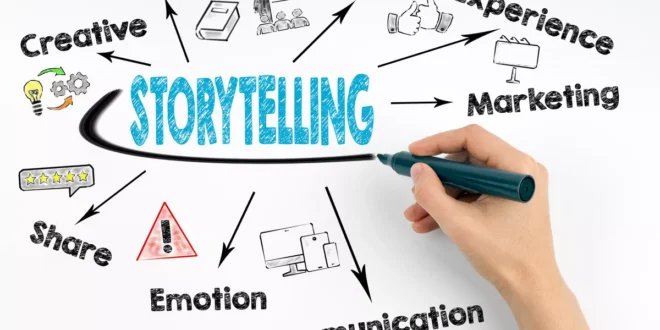If you want to make your marketing and advertising campaigns more effective, you can use each medium in your wheelhouse to tell a story. But what exactly is it about storytelling that makes it such an effective marketing tool? And what steps can you take to tell a great story to your target audience?
The Power of Storytelling
Whether you’re printing brochures, filming a video ad, or just making a post on social media, stories can help to ground and increase the power of your message. It’s hard to say exactly why human beings are so drawn to and enamored with stories; it could be a byproduct of our social nature or the fact that learning through experience is typically more effective than learning through instructions or words.
But in any case, the information presented as a story tends to be more persuasive and powerful than information presented in a straightforward, concise way. For example, which do you think is more powerful: flatly telling someone that lying is wrong, or telling the story of The Boy Who Cried Wolf? While the former is simpler and more to the point, the latter is much richer, showing people the concept with a somewhat plausible example.
If you can tell an effective story, your messaging is going to be much clearer, more persuasive, and more appealing to your target audience. So how do you tell an effective story in your marketing campaign?
How to Tell an Effective Story in Marketing

Stories come in all shapes and sizes, so you’ll have significant creative room here. But if you’re struggling to get started, and you want to make sure your story is as appealing as possible, these are some tips that can help you:
1. Start with a core concept
Before you start to put together a story, you need a core concept to provide a foundation for that story. The core concept of The Boy Who Cried Wolf is that lying is wrong and can harm you in some circumstances.
The core concept of The Tortoise and the Hare is that no consistent diligence is often more valuable than inconsistent bursts of activity. So what kind of message are you trying to get through to your audience? Once you have a clear understanding of this, boiled down to a single sentence, you’ll be in a much better position to put together a compelling story that illustrates it.
2. Draw from real life
There’s a reason why case studies are so powerful. It proves to people that a specific product or service is truly worth using. If you can, try to draw from real life. Real, human stories are often more powerful and persuasive than figurative or illustrative ones. Are there any former clients or people within your company who can provide the basis for your story?
3. Choose a relatable character

No matter what, you need a relatable character as part of your story, even if that character is non-human or without agency. As simple examples, the sun can be your main character, or your main character can be a teddy bear that a child loves and treasures.
The point is, there needs to be a center of your narrative journey – and it needs to be something that people will like or love.
4. Develop a beginning, middle, and end
Every story needs to have a coherent beginning, middle, and end. The beginning section is meant to establish context and draw readers in. The middle section is meant to develop characters, introduce conflicts, and offer increased complexity.
The end section is meant to provide resolution and reinforce the central messages of the piece. Your story is only going to be effective if you have some kind of narrative arc guiding it.
5. Educate
Stories should also teach something, even if you’re only teaching it implicitly. What is the main takeaway that you want readers to have from this story? And are you confident that your story is adequately presenting it?
6. Be original

There are many examples of storytelling in marketing out there, so you don’t want your materials to be written off as a cheap copy of someone else’s work. As much as possible, you should strive for originality in what you develop.
There’s not much you can do to break the most basic formulas of storytelling (unless you pull a Memento and present story events out of order), but you can create truly memorable, original characters and apply your own unique style to the story.
7. Cater to your target audience
Market research is a prerequisite for creating an effective story for your marketing and advertising campaign. If you know who your audience is, including what their values are and how they see the world, you’ll be in a much better position to write a story that’s persuasive to them.
8. Test and iterate
Don’t simply assume that your story is going to be effective because you thought about it really hard. You need to test your story in a live environment, preferably with a focus group. How do people respond? How can you make it better?
Building your marketing and advertising campaigns on the foundation of storytelling is a great way to enhance your capabilities while reaching more people. History is filled with brilliant marketers and advertisers who told compelling stories capable of redefining brands.
 Hi Boox Popular Magazine 2024
Hi Boox Popular Magazine 2024



